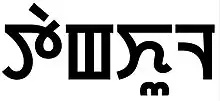| Tangkhul | |
|---|---|
| Luhupa | |
 Tangkhul written in Meitei script | |
| Native to | India |
| Region | Manipur, Nagaland |
| Ethnicity | Tangkhul people |
Native speakers | 140,000 (2001)[1] |
| Dialects |
|
| |
| Language codes | |
| ISO 639-3 | nmf |
| Glottolog | tang1336 |
| ELP | Tangkhul Naga |
Tangkhul is a Sino-Tibetan language of the Tangkhulic branch, spoken in different villages of Ukhrul district, Manipur, India. The term "Tangkhul" is derived from the Meitei language terms, "Tang" (Meitei: ꯇꯥꯡ, romanized: /tāng/) meaning "scarce" and "Khul" (Meitei: ꯈꯨꯜ, romanized: /khūl/) meaning "village" respectively.[2] According to another theory, the term "Tangkhul" is derived from "Thankhul", meaning "Than village" in Meitei language.[3][4][5]
Tangkhul became a written language for the first time in the year 1897, when William Pettigrew compiled "Tangkhul Primer and Catechism", during his Christian missionary activities.[6]
The Department of Language Planning and Implementation of the Government of Manipur offers a sum of ₹5,000 (equivalent to ₹8,500 or US$110 in 2023), to every individual who learns Tangkhul language, under certain terms and conditions.[7]
Tangkhul shares 93%–94% lexical similarity with the Somra variety of Tangkhul, 31% with Tangkhul Naga spoken in India, 51%–52% with Akyaung Ari Naga, and 29%–32% with Koki Naga.[8]
Phonology
Consonants
| Bilabial | Labio- dental |
Dental/ Alveolar |
Palatal | Velar | Glottal | ||
|---|---|---|---|---|---|---|---|
| Plosive | voiceless | p | t | k | ʔ | ||
| aspirated | pʰ | tʰ | kʰ | ||||
| Affricate | tʃ | ||||||
| Fricative | voiceless | f | s | h | |||
| nasalized | s̃ | ||||||
| voiced | z | ||||||
| Nasal | m | n | ŋ | ||||
| Rhotic | r | ||||||
| Lateral | l | ||||||
| Approximant | w | ʋ | j | ||||
- Stop sounds /p t tʃ k/ may have voiced allophones [b d dʒ ɡ] in free variation.
- /m/ may be heard as [ɱ] when preceding /f/ or /ʋ/.
- /r/ can be heard as [r] or [ɾ] in free variation.
Vowels
| Front | Central | Back | |
|---|---|---|---|
| Close | i | ɨ | u |
| Mid | e | ə | o |
| Open | a |
- /i e a u/ can have allophone sounds of [ɪ ɛ ɐ ɯ] in free variation.[9]
References
- ↑ Tangkhul at Ethnologue (18th ed., 2015) (subscription required)
- ↑ Sanyu, Visier (1996). A History of Nagas and Nagaland: Dynamics of Oral Tradition in Village Formation. University of Michigan. Commonwealth Publishers. p. 25. ISBN 978-81-7169-369-6.
... a sparse nature of settlement that the Tangkhul tribe got its name. In Meitei language-literally, Tang means scarce and khul means village.
- ↑ Shimray, A. S. W. (2001). History of the Tangkhul Nagas. Akansha Publishing House. p. 43. ISBN 978-81-87606-04-8.
... the village which they lived was known by the name ' THANKHUL ' meaning Than - Village in Meitei language . Therefore , the name ' TANGKHUL ' is derived from Than - Khul ...
- ↑ Lisam, Khomdan Singh (2011). Encyclopaedia Of Manipur (3 Vol.). Gyan Publishing House. p. 516. ISBN 978-81-7835-864-2.
The name Tangkhul was given to them by the Meiteis. There are many legends regarding the origin of the word Tangkhul.
{{cite book}}: CS1 maint: date and year (link) - ↑ "History | Ukhrul District, Government of Manipur | India". National Informatics Centre (in English and Manipuri). Government of India.
The name Tangkhul was given to them by their neighbours, the Meiteis. The northern Tangkhuls were also called the Luhupas.
{{cite web}}: CS1 maint: others (link) - ↑ S, Vangamla Salle K. (26 November 2023). "Manipur: Literature festival strives to promote Tangkhul language". EastMojo. Retrieved 27 November 2023.
- ↑ "Applications invited for local language training programme". Imphal Free Press.
- ↑ "Myanmar". Ethnologue: Languages of the World. 2016. Archived from the original on 10 October 2016.
- ↑ Ahum, Victor (1997). Tangkhul-Naga grammar: a study of word formation. New Delhi: Jawaharlal Nehru University.
